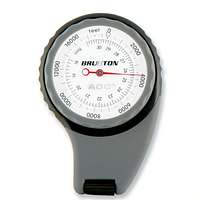ADC Ridge Mechanical Altimeter
Product Description and Features
This is a compact, handheld altimeter for gauging barometric pressure and altitude. It requires no batteries, is durable, reliable, and retails for around $40.Easily calibrated by reading the instructions and turning the altimeter scale ring. You will want a known altitude and current barometric reading for where you are when you calibrate it.
Measurements of altitude up to 16,300 ft. No metric markings.
Accurate within 50ft.
Consistent readings.
The altimeter is very sturdily built with a semi "non-slip" texture, which makes it easier to handle with cold hands.
The calibration bezel moves precisely and stays in place. It is a bit difficult to move, but that is also the sole reason it stays in place.
The scale also is marked in 100 ft. increments. (If you need more precise measurements then you'll have to spend over $150 for a quality digital version)
Images
Reviews
Viewing: 1-2 of 2 |
nartreb - Jul 11, 2011 3:51 pm - Voted 1/5
totally useless
I reviewed this altimeter here: Brunton ADC Ridge
Scarp172's review has me wondering whether I got a defective unit. Caveat emptor.
Scarp172's review has me wondering whether I got a defective unit. Caveat emptor.
Viewing: 1-2 of 2 |




Scarp172 - Jan 31, 2011 9:56 pm - Voted 5/5
An Excellent Navigational Tool, when used right.I purchased this altimeter as a navigational tool for use in Idaho's rugged back country and high peaks. I prefer to have as few things in my gear that require batteries as possible and this appeared to be an excellent choice based on other reviews. I have taken this altimeter up and down peaks in Idaho, Montana, Wyoming, and Washington and it has remained reliable and as accurate as a mechanical altimeter needs to be.
This altimeter is designed to help you navigate with map and compass to confirm your location, route, and to help plan routes or find waypoints. It will also show you the general trend in weather patterns if you make note of your barometric readings when you stop or any time you look at the altimeter. This will let you estimate if a storm is moving in, and if so, how quickly or if the weather will improve soon. This is always good information to have in the mountains.
Packing it:
You won't want this thing flopping around outside of your gear, but you'll want it somewhere accessible, should you need it. I keep mine in the upper pouch of my pack with the map, compass, headlamp, and first aid kit. I've had no problems with the bezel being moved at all while travelling, even when glissading, trail-running, or in the occasional fall.
What this altimeter is not.
What this altimeter will NOT do for you, because it is a simple, mechanical, navigational tool, is give you detailed information about the barometric pressure or exact altitude readings. It also lacks all of the fancy bells and whistles of more expensive digital models like clocks, alarms, thermometers, recording of rate of gain, maximum and minimum altitudes etc.
Most of the poor reviews I have seen on this product stem from either the user having much higher expectations about the product's performance than it was designed to give, or from the user not understanding the basic calibration and use of the altimeter. This is a tool designed to give readings to within 50 ft. of elevation to aid with topo map and compass navigation.
Summary
If you are looking for a simple, reliable, navigational tool for climbing in the high country and you don't want something that relies on batteries, this may be the tool for you. If you are looking for something that has a techno-savvy appeal, gives measurements within the nearest foot of elevation, has a barometric/weather alarm, or keeps track of trends in altitude gain and loss, then you may want to spend the extra money for a heavier digital altimeter or GPS unit.
One of my climbing partners has a Suunto Escape 203 and while the thermometer on it has been a good tool for us to have on climbs, it has proven to be highly unreliable and inconsistent in its altitude readings compared to my ADC Ridge. Also, in colder temperatures (below about 20 degrees Fahrenheit) the LCD screen freezes up and it either operates slowly or not at all. The cold is not kind to electronics of any sort.
This is a tool that I plan to keep with me whenever I plan on going into steep terrain and I imagine I'll put plenty of more miles on it in the future.